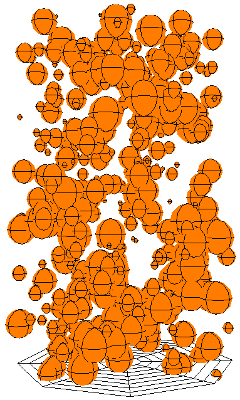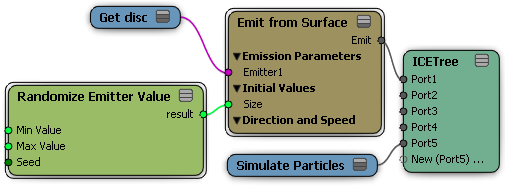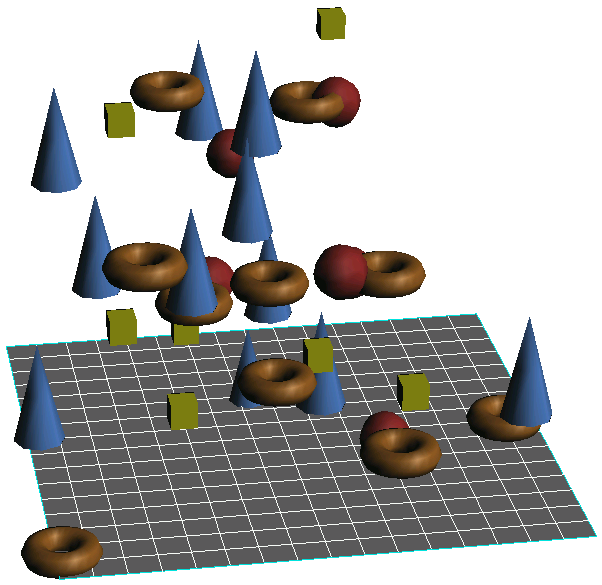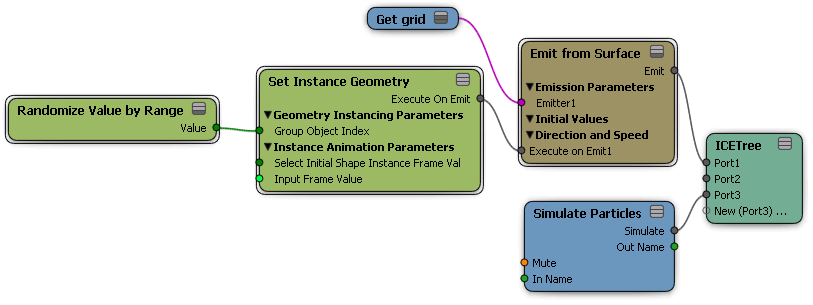You can control the variation of particle values by using random values. The Random compounds generate random values using different methods: either using a range of values, or using a mean value around which a variance is used.
Although similar in results at times, generating random values is different from turbulence. Randomizing means that values are randomly chosen (generated) from a range of values at every frame of the simulation. Turbulence, however, creates noise in fields over time and space.
To help out with using random values, you can set Seed values for the Random compounds. This value is used as the basis for the randomization. Changing the seed value allows you to create different random generations of values.
Randomizing Emit Compound Values
The Randomize Emitter Value compound applies random values to several parameters in the Emit compound: Rate, Direction, Speed, Mass, and Size.

Particle size is randomly changed upon emission.
To randomize particle emission values
Create a particle emission — see Setting Up Any Type of ICE Particle Emission.
Click the Task > Particles tab in the preset manager on the left side of the ICE Tree.
Select the Randomize Emitter Value compound from the Emission Control group, and drag it into the graph area.
Plug this compound's Result output into any of these ports of the Emit compound: Rate, Direction, Speed, Mass, or Size.

In the Randomize Emitter Value property editor, you can set the Seed (see above), Min/Max Values, and the distribution type:
Min/Max values define the range in which the random numbers are generated. A larger range of values yields a more obvious randomization effect.
Distribution Type determines how the randomization is applied to the values using one of these methods: Uniform, Gaussian, Triangle, and Profile Curve.
Uniform: random numbers are distributed uniformly: every value within the variance range is equally likely to be generated.
Gaussian: random numbers are distributed as a bell curve. Values close to the mean value are more likely to be generated. The likelihood smoothly diminishes as values are further from the mean.
Triangle: random numbers are distributed as a triangle that is peaked at the top. The likelihood of a value to be generated diminishes linearly as values are further from the mean.
Profile Curve: allows you to sculpt the distribution. The zero X value of the curve corresponds to the mean, while -1 and 1 are the limits of the distribution specified by the variance. The curve's values outside of this range are ignored.
The Randomize Value by Range is a simple compound that adds randomness to any parameter using a range of possible values.

Particle instance shapes are randomly chosen based on their index number in the Group Index.
Create a particle emission — see Setting Up Any Type of ICE Particle Emission.
Click the Task > Particles tab in the preset manager on the left side of the ICE Tree.
Select the Randomize Value by Range compound from the Modifiers group, and drag it into the graph area.
Plug this compound's Value output into ports that accept scalar values, such as ones on the Emit compound, but there are many others that work. For example, plug it into the Group Object Index port of the Set Instance Geometry compound to randomly choose from objects in a group for the shape of instanced geometry.

In the Randomize Value by Range property editor, you can set the Seed (see above) and the Min/Max values, which define the range in which the random numbers are generated. A larger range of values yields a more obvious randomization effect.
The Randomize Around Value compound adds randomness to any parameter using a mean value around which the random values are generated according to the variance level.
Create a particle emission — see Setting Up Any Type of ICE Particle Emission.
Click the Task > Particles tab in the preset manager on the left side of the ICE Tree.
Select the Randomize Around Value compound from the Modifiers group, and drag it into the graph area.
Plug this compound's Value output into ports that accept scalar values, such as ones on the Emit compound, but there are many others that work. For example, plug it into the Age Limit port on the Set Particle Age Limit compound to randomize the particles' age limits.
In the Randomize Around Value property editor you can set the Seed, base value, and variance:
Base Value: The mean value around which the random Variance value is calculated in any XYZ direction. For example, if this value is 2 in Y and the Variance value is 1, the value possibilities would be any value between 1 and 3 in Y.
Variance: the amount of variation of the randomness on either side of the Base Value.